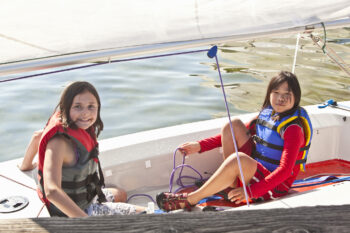Protect Kids and Teens from Cold Water Shock Drowning
5.16.2023 | Heather Cooper
 Warmer weather is cause for celebration in the Pacific Northwest, and many families choose to get outside to beat the heat and enjoy nature.
Warmer weather is cause for celebration in the Pacific Northwest, and many families choose to get outside to beat the heat and enjoy nature.
If your activities take you on or near the water, use extra caution this time of year as water temperatures are very cold even when air temperatures are warm.
Melting mountain snowpack makes rivers and lakes icy cold, causes rivers to run higher and faster, and raises the risk of drownings from cold water shock.
On the Pulse dives into the topic of cold water shock and how to recreate around water safely.
What is cold water shock?
When someone who is not wearing a life jacket is suddenly immersed in cold water, they can drown quickly, even if they are a strong swimmer. The reason is “cold water shock.”
Cold water shock starts with the gasp reflex. Our body’s automatic, instant response in very cold water is to gasp — a big, sudden inhale. If the head is underwater, the gasp pulls water into the lungs. This often triggers choking, panic and hyperventilation — very fast, shallow breathing. Death can occur in just a few minutes.
It surprises many people to know that cold water shock causes many more deaths than hypothermia. Hypothermia happens when the body’s temperature is too low for too long, leading to a loss of the strength that is required to swim.
How can wearing a life jacket help?
Wearing a properly fitting U.S. Coast Guard-approved life jacket is so important for kids and adults.
In cases of sudden, unexpected entry into cold water — such as falling overboard off a boat, flipping a canoe or kayak, or slipping into a river — a life jacket keeps the head up out of the water.
Life jackets allow floating and reduce heat loss whether purposely or unexpectedly entering the water. If your family adventures involve water — regardless of its temperature — be sure everyone wears a life jacket that is the right size and fit. And be sure to keep life jackets snugly fastened.
Adults are important role models and can normalize life jacket use for their kids and teens when they wear them, too.
How common is drowning?
Drowning is a leading cause of injury death among kids of all ages. Children under 5 have the highest drowning rate and most often drown in bathtubs and swimming pools.
Teens ages 15 to 19 have the second highest rates of drowning. They’re most likely to drown in lakes and rivers in this part of the country.
It’s much more difficult to swim in open water than in pools, where many teens have most of their swimming experience.
What else can my family do to be safe around water?
Be sure kids of all ages are closely supervised when wading or swimming, even if a lifeguard is present, and that children, teens and adults learn how to swim.
Keep young children within an arm’s length – in touching distance – when in and around water. Never leave a baby or toddler alone in the bath for even a moment.
Supervise young children when water is anywhere nearby. Drownings in this age group often happen when water play wasn’t planned.
At the beach, it’s best to choose areas with lifeguards, but even when lifeguards are present, an adult should remain distraction-free and substance-free as they watch kids in and near water.
Help teens be water smart and know their limits. Independence and peer pressure can put them in dangerous situations. Parents and caregivers can set firm rules and expectations around safety when teens are going to be in or near the water.
Be Prepared and Stay Safe
Drowning can happen anywhere, at any time of year, indoors or outdoors. Learn first aid and CPR, keep a phone with you and know water rescue skills for when your family’s water recreation takes you to the great outdoors.
Every year in Washington State, children die in our rivers, lakes, ponds, Puget Sound and ocean that are cold year-round. Using what we know about water safety we can all help prevent future drownings.